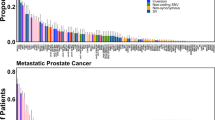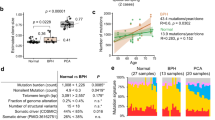Abstract
Cancer pathogenesis involves multiple genetic and epigenetic alterations, which result in oncogenic changes in gene expression. δ-Catenin (CTNND2) is overexpressed in cancer, although the mechanisms of its upregulation are highly variable. Here we report that in prostate cancer, the methylation of CpG islands in the δ-catenin promoter was not a primary regulatory event. There was also no δ-catenin gene amplification. However, using the single-strand conformation polymorphism analysis, we observed the increased nucleotide changes in the 5′-untranslated region of δ-catenin gene in human prostate cancer. At least one such change (−9 G>A) is a true somatic point mutation associated with a high Gleason's score, poorly differentiated prostatic adenocarcinoma. Laser capture microdissection coupled with PCR analyses detected the mutation only in cancerous but not in the adjacent benign prostatic tissues. Using chimeric genes encoding the luciferase reporter, we found that this mutation, but not a random mutation or a mutation that disrupts an upstream open reading frame, resulted in a remarkably higher expression and enzyme activity. This mutation did not affect transcriptional efficiency, suggesting that it promotes δ-catenin translation. This is the first report of δ-catenin gene mutation in cancer and supports the notion that multiple mechanisms contribute to its increased expression in carcinogenesis.
This is a preview of subscription content, access via your institution
Access options
Subscribe to this journal
Receive 50 print issues and online access
$259.00 per year
only $5.18 per issue
Buy this article
- Purchase on Springer Link
- Instant access to full article PDF
Prices may be subject to local taxes which are calculated during checkout





Similar content being viewed by others
References
Burger MJ, Tebay MA, Keith PA, Samaratunga HM, Clements J, Lavin MF et al. (2002). Expression analysis of delta-catenin and prostate-specific membrane antigen: their potential as diagnostic markers for prostate cancer. Int J Cancer 100: 228–237.
Cervera M, Sanchez S, Molina B, Alcantara MA, Del Castillo V, Carnevale A et al. (2005). Trisomy of the short arm of chromosome 5 due to a de novo inversion and duplication (5) (p15.3 p13.3). Am J Med Genet A 136: 381–385.
Duparc RH, Boutemmine D, Champagne MP, Tétreault N, Bernier G . (2006). Pax6 is required for delta-catenin/neurojungin expression during retinal, cerebellar and cortical development in mice. Dev Biol 300: 647–655.
Fatima S, Chui CH, Tang WK, Hui KS, Au HW, Li WY et al. (2006). Transforming capacity of two novel genes JS-1 and JS-2 located in chromosome 5p and their overexpression in human esophageal squamous cell carcinoma. Int J Mol Med 17: 159–170.
Griffin E, Re A, Hamel N, Fu C, Bush H, McCaffrey T et al. (2001). A link between diabetes and atherosclerosis: glucose regulates expression of CD36 at the level of translation. Nat Med 7: 840–846.
Ho C, Zhou J, Medina M, Goto T, Jacobson M, Bhide PG et al. (2000). Delta-catenin is a nervous system-specific adherens junction protein which undergoes dynamic relocalization during development. J Comp Neuro 420: 261–276.
Horoszewicz JS, Leong SS, Kawinski E, Karr JP, Rosenthal H, Chu TM et al. (1983). LNCaP model of human prostatic carcinoma. Cancer Res 43: 1809–1818.
Huang FY, Chiu PM, Tam KF, Kwok YK, Lau ET, Tang MH et al. (2006). Semi-quantitative fluorescent PCR analysis identifies PRKAA1 on chromosome 5 as a potential candidate cancer gene of cervical cancer. Gynecol Oncol 103: 219–225.
Kaighn ME, Narayan KS, Ohnuki Y, Lechner JF, Jones LW . (1979). Establishment and characterization of a human prostatic carcinoma cell line (PC-3). Invest Urol 17: 16–23.
Kim K, Oh M, Ki H, Wang T, Bareiss S, Fini ME et al. (2008). Identification of E2F1 as a positive transcriptional regulator for delta-catenin. Biochem Biophys Res Commun 369: 414–420.
Kindich R, Florl AR, Jung V, Engers R, Müller M, Schulz WA et al. (2005). Application of a modified real-time PCR technique for relative gene copy number quantification to the determination of the relationship between NKX3.1 loss and MYC gain in prostate cancer. Clin Chem 51: 649–652.
Lang D, Mascarenhas JB, Powell SK, Halegoua J, Nelson M, Ruggeri BA . (2008). PAX6 is expressed in pancreatic adenocarcinoma and is downregulated during induction of terminal differentiation. Mol Carcinog 47: 148–156.
Livak KJ, Schmittgen TD . (2001). Analysis of relative gene expression data using real-time quantitative PCR and the 2(−Delta Delta C (T)), method. Methods 25: 402–408.
Lu Q, Dobbs LJ, Gregory CW, Lanford GW, Revelo MP, Shappell S et al. (2005). Increased expression of ä-catenin/neural plakophilin-related armadillo protein is associated with the down-regulation and redistribution of E-cadherin and p120ctn in human prostate cancer. Hum Pathol 36: 1037–1048.
Lu Q, Paredes M, Medina M, Zhou J, Cavallo R, Peifer M et al. (1999). Delta-catenin, an adhesive junction-associated protein which promotes cell scattering. J Cell Biol 144: 519–532.
Marinescu RC, Johnson EI, Dykens EM, Hodapp RM, Overhauser J . (1999). No relationship between the size of the deletion and the level of developmental delay in Cri-Du-Chat syndrome. Am J Med Genet 86: 66–70.
Mayes DA, Hu Y, Teng Y, Siegel E, Wu X, Panda K et al. (2006). PAX6 suppresses the invasiveness of glioblastoma cells and the expression of the matrix metalloproteinase-2 gene. Cancer Res 66: 9809–9817.
Medina M, Marinescu RC, Overhauser J, Kosik KS . (2000). Hemizygosity of delta-catenin (CTNND2) is associated with severe mental retardation in Cri-Du-Chat syndrome. Genomics 63: 157–164.
Murthy SK, Magliocco AM, Demetrick DJ . (2005). Copy number analysis of c-erb-B2 (HER-2/neu) and topoisomerase IIalpha genes in breast carcinoma by quantitative real-time polymerase chain reaction using hybridization probes and fluorescence in situ hybridization. Arch Pathol Lab Med 129: 39–46.
Nakayama S, Sasaki A, Mese H, Alcalde RE, Tsuji T, Matsumura T . (2001). The E-cadherin gene is silenced by CpG methylation in human oral squamous cell carcinomas. Int J Cancer 93: 667–673.
Paffenholz R, Franke WW . (1997). Identification and localization of a neurally expressed member of the plakoglobin/armadillo multigene family. Differentiation 61: 293–304.
Paffenholz R, Kuhn C, Grund C, Stehr S, Franke WW . (1999). The arm-repeat protein NPRAP (neurojungin) is a constituent of the plaques of the outer limiting zone in the retina, defining a novel type of adhering junction. Exp Cell Res 250: 452–464.
Pretlow TG, Wolman SR, Micale MA, Pelley RJ, Kursh ED, Resnick MI et al. (1993). Xenografts of primary human prostatic carcinoma. J Natl Cancer Inst 85: 394–398.
Ren B, Yu G, Tseng GC, Cieply K, Gavel T, Nelson J et al. (2006). MCM7 amplification and overexpression are associated with prostate cancer progression. Oncogene 25: 1090–1098.
Signori E, Bagni C, Papa S, Primerano B, Rinaldi M, Amaldi F et al. (2001). A somatic mutation in the 5′UTR of BRCA1 gene in sporadic breast cancer causes down-modulation of translation efficiency. Oncogene 20: 4596–4600.
Sramkoski RM, Pretlow II TG, Giaconia JM, Pretlow TP, Schwartz S, Sy MS et al. (1999). A new human prostate carcinoma cell line, 22Rv1. In Vitro Cell Dev Biol Anim 35: 403–409.
Stone KR, Mickey DD, Wunderli H, Mickey GH, Paulson DF . (1978). Isolation of a human prostate carcinoma cell line (DU 145). Int J Cancer 21: 274–281.
Tanahashi H, Tabira T . (1999). Isolation of human delta-catenin and its binding specificity with presenilin 1. Neuroreport 10: 563–568.
Umbas R, Isaacs WB, Bringuier PP, Schaafsma HE, Karthaus HF, Oosterhof GO et al. (1994). Decreased E-cadherin expression is associated with poor prognosis in patients with prostate cancer. Cancer Res 54: 3929–3933.
Weijerman PC, Konig JJ, Wong ST, Niesters HG, Peehl DM . (1994). Lipofection- mediated immortalization of human prostatic epithelial cells of normal and malignant origin using human papillomavirus type 18 DNA. Cancer Res 54: 5579–5583.
Zhang HT, Chen XF, Wang MH, Wang JC, Qi QY, Zhang RM et al. (2004). Defective expression of transforming primary non-small cell lung cancer. Clin Cancer Res 10: 2359–2367.
Zheng M, Simon R, Mirlacher M, Maurer R, Gasser T, Forster T et al. (2004). TRIO amplification and abundant mRNA expression is associated with invasive tumor growth and rapid tumor cell proliferation in urinary bladder cancer. Am J Pathol 165: 63–69.
Zhou J, Liyanage U, Medina M, Ho C, Simmons AD, Lovett M et al. (1997). Presenilin interaction in the brain with a novel member of the armadillo family. Neuroreport 8: 2085–2090.
Acknowledgements
We thank Melissa Clark and GW Lanford for excellent technical assistance, and Lu laboratory members for many helpful discussions. This study was supported in part by NIH/NCI (CA111891) and the Department of Defense (PC040569) grants (QL).
Author information
Authors and Affiliations
Corresponding author
Additional information
Supplementary information accompanies the paper on the Oncogene website (http://www.nature.com/onc)
Rights and permissions
About this article
Cite this article
Wang, T., Chen, YH., Hong, H. et al. Increased nucleotide polymorphic changes in the 5′-untranslated region of δ-catenin (CTNND2) gene in prostate cancer. Oncogene 28, 555–564 (2009). https://doi.org/10.1038/onc.2008.399
Received:
Revised:
Accepted:
Published:
Issue Date:
DOI: https://doi.org/10.1038/onc.2008.399
Keywords
This article is cited by
-
Heritable genomic diversity in breast cancer driver genes and associations with risk in a Chilean population
Biological Research (2022)
-
Genetic alterations of δ-catenin/NPRAP/Neurojungin (CTNND2): functional implications in complex human diseases
Human Genetics (2016)
-
δ-Catenin, a Wnt/β-catenin modulator, reveals inducible mutagenesis promoting cancer cell survival adaptation and metabolic reprogramming
Oncogene (2015)
-
Genomic characterization of three urinary bladder cancer cell lines: understanding genomic types of urinary bladder cancer
Tumor Biology (2014)
-
Two functional variations in 5′-UTR of hoGG1 gene associated with the risk of breast cancer in Chinese
Breast Cancer Research and Treatment (2011)



